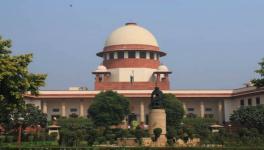Exclusionary Development: How Can the Sealing Drive Affect the Population and the Pollution?

Image Courtesy: Financial Express
The Supreme Court (SC) of India is turning elitist while reasoning the continuation of the sealing drive in Delhi. The two-member bench of the SC—while commenting on the sealing drive—called for shifting of the capital of the country, like Tughlaq did in the 14th century, while the other option it offered was to “act now” to ‘save Delhi’. This may sound quite heartening, but the reasons put forth by the eminent judges are elitist – pointing towards eventual exclusion.
The learned judges have targeted the unauthorised constructions, and have termed them a reason for rising pollution in the city. They have also said that the lungs of the residents are getting affected and the children are the ones facing the worst effects of the pollution. While it is undeniable that the air ambience of Delhi is extremely poor, but citing unauthorised constructions as the reason for it is misguided. There are multiple reasons behind the poor air quality of Delhi – automobile emissions being the principal one. The growing aspiration of the middle class to own and drive a car is a major reason behind the increasing pollution.
However, judges seem to have a bias for the upper middle-class, and have not pondered over the way the city has been developed. Proper planning was absent while drafting the master plans. Even some of the positive elements of the previous plans (1962 Master plan) like spaces for social housing, have not been executed by the executing agencies (Delhi Development Authority). The urban development of Delhi has primarily meant development of the roads and the movement of the cars. The spaces for the pedestrians have been usurped through the widening of roads, which encourages the residents to buy more cars. The flyovers constructed in the city with enormous public money facilitate rapid movement of the giant guzzlers. This has not been ridiculed.
The guiding principle for the holistic development ought to be a healthy public transport. The short distance transport needs to be improved, as millions of workers, who work as domestic helps, construction workers, and service sector workers, live in the vicinity of their workplace. What they require is a safe pedestrian path or a well-defined bicycle route or a bus connection. However, the focus of the modern day planners and even our jurists is not on the public transport. Rather, they are guided by an elitist outlook to ensure that the cars move fast. On the other hand, the habitats of the poor are being termed unauthorised settlements.
The present sealing drive is also directed in the same direction. The whole argument of not allowing mixed land use plan is an act of favouring the rich and high-end consumers living in the city. Lessons must be learnt from how Le Carbousier built Chandigarh, where a sector was defined as a living unit of the area. The drive to the commercial units in the city will impact more than 6 lakh traders according to the general secretary of the Confederation of All India Traders (CAIT), Praveen Khandelwal. The cascading effect it will have on the families linked to them will be even more.
The sheer paranoia of not having any activity in the residential areas has already affected the movement of the business establishments from some of the localities. A famous Bengali sweet shop ‘Annapurna’ – just next to the Green Park metro station –has shut down, as its manufacturing unit nearby, was sealed. Likewise, a lot of traders have either halted their work or are in the process of moving to other places. One of the areas, where this rapid shift is taking place, happens to be the Lal Dora village in the city. The Lal Dora was considered to be a rural habitation area, where the building bylaws of the municipality would not apply. There are 362 villages in Delhi, out of which 135 are classified as urban villages and 227 are classified as rural villages. With the present imbroglio of sealing drive, much of the activity has moved to these villages. In these villages, the regulation of the land use is hardly applicable, thus, increasing the vulnerability of the region and the people.
The exercise to shift the business establishment from the residential areas to designated commercial spaces is guided by the business interests of big builders in the city. The planning of the large commercial spaces—where huge malls have come up—is a step towards throwing the small traders out of the bracket. The small traders do not have the capacity to buy outlets in such commercial spaces. So, the big giants –both national and trans-national occupy such outlets, throwing the small traders out of the race altogether. Now, what seems like a better option? Forcing millions of people in the city to go away from their homes to buy consumer goods or ensuring that the same goods can be made available at a walking distance? In the first instance, the people will be using different modes of transport – emitting a lot of carbon gases, and thereby polluting the environment. Whereas, in case of the second proposition, the people would hardly use the transport, thereby not contributing to the growing pollution.
Unfortunately, the SC, with all its wisdom, has not pondered upon the problem in a holistic manner. It has been too mechanical in adopting a yardstick to throw a large number of people out of the city and away from their livelihood. It is shocking that without even allowing a due course of trial, a blanket dictum is deriding over the lives of lakhs of people. The defaulters (if at all they are) should have been individually tried in the court of the municipal magistrate first and then the sealing should have been carried out. They have not even been heard. This is highly exclusionary on the part of the apex court.
We all know the city is quite dear to the hearts of its residents and for the Hon’ble judges, more than anybody else. But the cities have to be highly liveable and inclusionary while being developed. We know how Paris was built by Haussman and similar cities built by Moses in the US. But, we also know how both Haussman and Moses are treated in history. Let’s hope the Hassmanisation of our apex court does not take place.
Get the latest reports & analysis with people's perspective on Protests, movements & deep analytical videos, discussions of the current affairs in your Telegram app. Subscribe to NewsClick's Telegram channel & get Real-Time updates on stories, as they get published on our website.
























